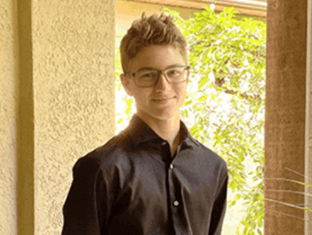The Challenge: Drug-Resistant Epilepsy
Summer is typically a time of relaxation when teenagers escape the stresses of academic life. But the summer of 2018 proved to be quite a different experience for now 16-year-old Michael Albers of Akron, OH, and his parents, Ken and Annette.
“Since the surgery, I haven’t had one seizure. I have a job now, I’m able to drive, and I play lacrosse. I certainly took a very good turn for the better.” — Michael
What started as an ordinary summer quickly turned into frustration for Michael, as he began experiencing peculiar sensations in his head. The “strange feeling” overwhelmed him and became increasingly frequent during a two-week period.
“Michael didn’t get dizzy or experience any loss of body function, but he’d have to stop whatever he was doing completely to calm down,” says Ken.
Schedule an Appointment or Ask a Question
“He would suffer multiple episodes a day, sometimes as close as seven minutes apart,” says Annette.
Growing concerned for Michael and his health, the Albers family knew they needed to seek help. They saw a non-UPMC neurologist who diagnosed him with focal epilepsy and prescribed medication to reduce the seizure activity.
While the medicine slightly decreased the frequency of seizures, Michael’s quality of life rapidly declined.
“He had to stop playing baseball and soccer and his social life certainly took a hit,” says Ken. “The medication affected his academic life as well because he was always exhausted and unable to focus.”
Trips to the emergency room became the new normal for Michael and his family, as they attempted to calm the extreme nausea prompted by the medicine.
It was a complicated process to determine a combination of medicine and correct dosages that did not make Michael feel ill. Despite the medicine adjustments, Michael still experienced frequent seizures and could not yet fully return to his normal life.
The Journey to UPMC
In 2019, Michael and his family met neurosurgeon Jorge González-Martínez, MD, PhD, FAANS, who was practicing with another institution at the time. Dr. González-Martínez presented surgery as the best option for reducing Michael’s irregular brain activity. His recommendation was to locate and remove the seizure focus — the part of the brain where seizures are triggered — to hopefully achieve seizure freedom.
While the Albers family considered their options, Dr. González-Martínez began practicing with UPMC. The Albers family felt extremely confident in Dr. González-Martínez’s abilities, which encouraged them to travel to UPMC and continue treatment discussions at UPMC Children’s Hospital of Pittsburgh.
Michael’s parents were very worried at the thought of having their son undergo brain surgery, but they remained focused on the ultimate goal — to have Michael live a seizure-free life. Michael was also prepared to do whatever was necessary in hopes of stopping his seizures once and for all. “I remained calm and was willing to go through the process,” says Michael.
The Solution: Epilepsy Surgery
Michael had his first surgery in February 2020 to pinpoint where the seizures were originating. A stereoelectroencephalography (sEEG) helped the team determine the exact location of the irregular brain activity.
“The key for us was the sEEG because they realized that Michael was seizing all the time even though he only recognized some of them,” says Annette.
After the analysis of the sEEG, a craniotomy was recommended as the next step toward seizure freedom. Michael decided to undergo the craniotomy in May 2020, which removed the part of the brain responsible for causing his seizures.
Multiple UPMC physicians expressed genuine enthusiasm for the success of Michael’s procedure.
"Not only were they so excited to tell us that he did well,” says Ken, “but they could see his brain activity going back to normal in real time — immediate results!"
After a one-week recovery period at UPMC Children’s, Michael continued to take his medications for the first six months after surgery and was gradually weaned off them all.
The Result: A Return to Normal Teenage Life
Today, Michael is taking advantage of the normal teenage opportunities he was unable to enjoy for two years while experiencing his seizures.
“Since the surgery, I haven’t had one seizure,” says Michael. “I have a job now, I’m able to drive, and I play lacrosse. I certainly took a very good turn for the better.”
Inspired by the work of Dr. González-Martínez and his team, Michael has plans to return to UPMC sooner than one might think — and this time, not for his own care.
“It is my goal to work as a nurse anesthetist for UPMC and comfort other patients who are going through experiences similar to my own,” says Michael.
“We were always worried about him,” says Ken. “Not only was it great to have the surgery, but the success that resulted from it was truly remarkable.”
Our patient stories profile a number of patients who have had minimally invasive brain surgery at UPMC. Although everyone's care experience is unique, we hope that sharing these stories will help other prospective patients and their families better understand these procedures and their potential benefits.
Michael’s treatment and results may not be representative of all similar cases.

















